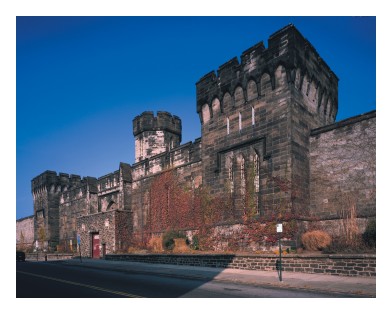2027 Fairmount Ave
Philadelphia, PA 19130
United States
Eastern State Penitentiary
Eastern State Penitentiary


The gigantic Gothic castle that is Eastern State Penitentiary was a product of the eighteenth-century movement to reform prisons. Like other visionary projects of the Enlightenment, such as the establishment of democracy and the abolition of slavery, the crusade for prison reform was shaped by the belief that humans had the ability to change their circumstances. The building was designed to guide those convicted of crimes to repent and reform themselves.
Leading the reform effort was the Philadelphia Society for Alleviating the Miseries of Public Prisons, the first such organization in the world. It was founded in 1787 by Dr. Benjamin Rush, and Benjamin Franklin was among the first members. At the group’s urging, in 1791 the state built a block of one-person cells in the Walnut Street Jail. This tested the belief that solitary confinement, which isolated prisoners from the bad influence of other criminals, could also encourage self-examination and transformative penitence—hence the term “penitentiary.”
At the urging of the Society, in 1821 the Pennsylvania legislature approved funding to build the Eastern State Penitentiary on the new model, and architects were invited to submit designs. The English-born John Haviland (1792-1852) was selected for his radial plan, with cell blocks arranged like the spokes of a wheel. He argued that this layout, inspired by prisons and asylums recently erected in England and Ireland, promoted “watching, convenience, economy and ventilation.”
Construction began in what was then the countryside, more than a half mile north of the city, in 1822. The first prisoner was admitted in 1829, and the construction of Haviland’s seven-wing plan was completed in 1833—but with the final four blocks enlarged (lengthened and raised to two stories) to accommodate the growing prison population. The implementation of solitary confinement meant that each cell required its own exercise yard, central heat, running water, and a toilet, which made construction immensely expensive.
The design was visually distinctive, and, combined with what came to be called the “Pennsylvania System” of solitary confinement, it was emulated for hundreds of prisons throughout the world over the next century. The prison also became a popular destination for tourists, 10,000 of whom visited in 1858, the peak year.
However, solitary confinement was almost immediately criticized as inhumane and ineffective. Its most famous critic was Charles Dickens, who declared that Eastern State and Niagara Falls were the most important destinations of his 1842 travels in the United States. Having visited the prison, he wrote that the Pennsylvania System was “cruel and wrong." In practice, it seems that solitary confinement was inconsistently enforced, most obviously in the employment of convict work gangs to build the prison. But it was not until 1913 that the Pennsylvania System was officially abandoned.
The prison continued to be enlarged in the twentieth century, with additional cell blocks wedged between the original wings. In 1929-30 Chicago gangster Al Capone spent eight months at Eastern State, in a cell that he was allowed to decorate lavishly. In 1945 Willy Sutton led a briefly successful group escape through a tunnel.
In 1970 Pennsylvania ceased the operation of the penitentiary. After being used briefly as a city jail, the building stood empty and at risk of demolition until 1988, when, at the urging of the new Eastern State Penitentiary Task Force, Mayor Wilson Goode halted the process of selling the site. Regular public access began in 1994.